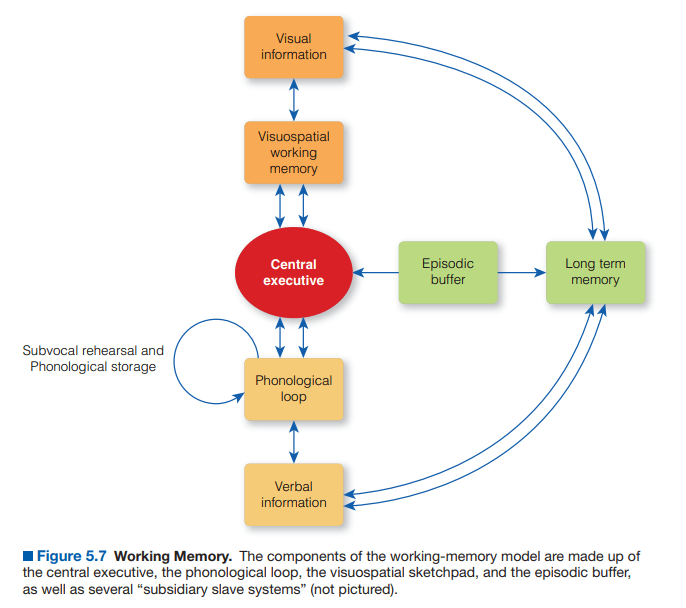Introduction
Working memory is a core component of human cognition that allows individuals to temporarily store, manipulate, and use information in real-time. It is essential for complex cognitive tasks such as problem-solving, reasoning, language comprehension, and decision-making. Unlike long-term memory, which stores information over extended periods, it is limited in both capacity and duration.
What is Working Memory?
Working memory is a dynamic system responsible for the short-term storage and processing of information. It is often confused with short-term memory, but the two concepts differ significantly. Short-term memory merely holds information for a brief period, whereas it is responsible for actively manipulating that information (Dosher, 2003; Sternberg & Sternberg, 2017).
The concept of working memory was popularized by Alan Baddeley, who proposed a multi-component model comprising the phonological loop, visuospatial sketchpad, central executive, and later, the episodic buffer (Baddeley, 2007). This model highlights the complexity and specialized nature of it.
Read More- Memory
Components of Working Memory
It has four important components, they include-

Working Memory
1. The Phonological Loop
The phonological loop is responsible for processing auditory and verbal information. It consists of two main components-
- Phonological Store- Temporarily holds auditory information for a few seconds.
- Subvocal Rehearsal- Repeats the information internally to prevent decay.
This subsystem is critical for tasks such as language comprehension, speech production, and learning new words (Baddeley, 2000b). For example, when trying to memorize a phone number, people tend to repeat it in their minds—a process facilitated by the phonological loop.
2. The Visuospatial Sketchpad
The visuospatial sketchpad processes and stores visual and spatial information. It enables people to visualize images, navigate environments, and perform mental rotations of objects. According to Logie (1995), the visuospatial sketchpad consists of:
- The Visual Cache- Stores visual information such as color and shape.
- The Inner Scribe- Manages spatial and movement-related details.
This subsystem is crucial for activities such as reading maps, recalling visual scenes, and solving puzzles.
3. The Central Executive
The central executive is the control system that regulates attention, coordinates information from the phonological loop and visuospatial sketchpad, and manages cognitive tasks requiring focus. It plays a vital role in multitasking and decision-making (Baddeley, 2007).
One significant function of the central executive is task-switching, which allows individuals to shift focus between different tasks effectively. Research suggests that bilingual individuals develop stronger central executive functions due to the constant need to manage multiple languages (Abutalebi & Green, 2007; Bialystock et al., 2014).
4. The Episodic Buffer
Introduced as a later addition to the model, the episodic buffer integrates information from different sources into a unified representation. It links working memory to long-term memory and helps create coherent episodes of experience (Baddeley, Eysenck, & Anderson, 2009).
For instance, when recalling a past vacation, the episodic buffer combines visual memories, sounds, and emotions to reconstruct the experience.
Cowan’s Embedded Processes Model
Cowan (2005) argued that working memory is a subset of activated long-term memory. This model emphasizes the role of attention in determining which information is held in the focus of awareness at any given time.
Neuroscience of Working Memory
Recent advances in neuroscience have identified key brain regions associated with working its functions-

Parts Related to Working Memory
- Phonological Loop- Left temporal and frontal lobes, including Broca’s area (Paulesu et al., 1993).
- Visuospatial Sketchpad- Occipital and parietal lobes (Logie & Della Sala, 2005).
- Central Executive- Dorsolateral prefrontal cortex, responsible for attentional control (Buchsbaum & D’Esposito, 2014).
- Episodic Buffer- Bilateral activation in the frontal lobes and hippocampus (Rudner et al., 2007).
Neuroimaging studies using fMRI and PET scans have confirmed that its functions rely on distributed neural networks rather than a single localized brain region.
Measuring Working Memory
Researchers assess working memory using various tasks-

Task to Measure Working Memory
- N-Back Task- Measures updating and monitoring of information.
- Digit Span Task- Evaluates memory span by requiring recall of number sequences.
- Retention-Delay Task- Assesses the ability to retain and recognize items after a short interval (Baudouin et al., 2006).

Digit Span Forward
These tests help identify individual differences in working memory capacity and detect deficits associated with neurological conditions.
Conclusion
Working memory is a foundational cognitive system that supports essential mental functions. Understanding its components, theoretical models, and neural underpinnings has significant implications for education, clinical psychology, and artificial intelligence. As research progresses, uncovering new insights about it could revolutionize fields ranging from cognitive neuroscience to human-computer interaction.
References
Baddeley, A. (2000b). The episodic buffer: A new component of working memory? Trends in Cognitive Sciences, 4(11), 417–423.
Baddeley, A. (2007). Working Memory, Thought, and Action. Oxford University Press.
Cowan, N. (2005). Working Memory Capacity. Psychology Press.
Engel de Abreu, P. M. J., et al. (2014). The influence of working memory on academic performance. Journal of Educational Psychology, 106(1), 10–18.
Sternberg, R. J., & Sternberg, K. (2017). Cognitive Psychology. Cengage Learning.
Subscribe to Careershodh
Get the latest updates and insights.
Join 16,602 other subscribers!
Niwlikar, B. A. (2025, January 9). Working Memory and Its 4 Important Systems. Careershodh. https://www.careershodh.com/working-memory/
